Fran Callen
– Helpmann Academy, Australia
The experience of staying
at Sanskriti Kendra itself, it was like living in
some kind of artist's paradise for six weeks. To
be surrounded by such inspiring people of varied
talents and backgrounds, the peaceful garden, the
fascinating art galleries
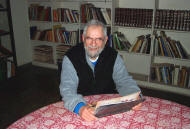
(and there's elements of the
art in those - particularly the everyday art museum
-that still influence the direction of art I make
now) and that amazing food, and just to have the
freedom to soak ourselves in India, and to share
our ideas, and make art, it was absolutely awesome.
The connection with the other artists on our residency,
continues, and we meet up and collaborate on art
ventures quite regularly in different ways. And
there continues to be references to India in each
artists work. The experience of working with the
children at Jamghat Boys Home, and at Dhanak Din
Festival, was moving and eye opening, and I have
a large collection of photos, which I aim to use
as source material for paintings.
So, the experience of that residency at Sanskriti
Kendra continues to influence the art I make now,
and it's only a start, as I have many more plans
related to the material I collected there.
Seyda Sever [Turkey] Photographer
UNESCO 2001
“As a photographer I spent most of my
time working in Delhi City. …when I came back
to Sanskriti it felt like coming home…I learnt
so much about Indian culture and life as well as
other cultures. Sanskrit gave me a perfect environment
to reflect and most beautiful people from India
and the rest of the world to interact with and sometimes
it was enlightening. I made many friends.”
Lham Dorji [Bhutan] South Asian Program 2001-2002
“Sanskriti is not simply a place of intellectual
development. It rather contributes towards individual's
realisation of the need for his or her mutual co-existence
with the natural environment”
|
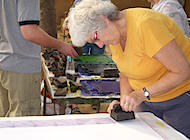
Gretchen Cochran –Professor Otterbein University,
Ohio, USA
We found the facilities to be significantly
developed. The textile museum is fantastic, as was
The tour with the resource person. Students enjoyed
the privacy the lounge provided from the social
challenges of group housing. Improved lighting made
a big difference in students' being able to work
at night. We enjoyed all of the resource presentations.
Students really enjoyed the person who taught us
about Warli painting. The evening with the Rajasthani
performers was well beyond our expectations. All
resource sessions were very valuable.
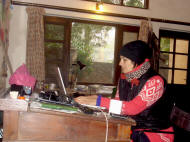
Making trips to both Jaipur and Agra in so short
a time, was a bit taxing, but I would hate to think
of our not having the visits to village printers
.
The Sanskriti staff was amazing. They helped in
every way imaginable to anticipate and to meet a
wide variety of requests. The Education students
in particular, appreciated the opportunity to visit
a school. The Heritage tours were substantial, well
planned, well presented and memorable. Thank you.
The intellectual high point of the trip was the
conversation with Dr. Jain. His remarks dislodged
us from our parochial assumptions and challenged
us to think more deeply and from a broader perspective.
Sanskriti facilities provided an oasis from the
rigors of travel, and set the stage for both serious
thought and personal insight. This is truly a magical
place. The opportunity to interact with students
and artists from several different countries was
invaluable.
We are very grateful for the significant efforts
so many of you invested in our visit.
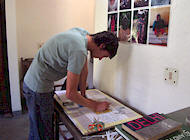
Oliver Barstow [South Africa], UNESCO Aschberg Bursaries
for Creative Writing, 2005-2006
"The experience I gained
at Sanskriti was invaluable to my development as
a person. The nature of the residency provided the
space in which to explore new ideas and new modes
of expressing these ideas without any parameters
being set or any sort of teacher-student relationship
being enforced.
Although I entered the residency program as a writer
I found the environment far more conducive to the
production of visual work. It has long been my ambition
to explore ways in which writing – the book
in particular – might interact with visual
imagery. I used the time at the residency to explore
this relationship more fully and much of the work
I produced could be more comfortably defined in
this dual relationship. It also seems that I was
not alone in this experience. Other artists who
conventionally worked in visual mediums ended up
experimenting with the written word. Being based
in Delhi was one of the highlights of the stay,
affording the oppurtunity to meet a range of locals
involved in the arts and to interact on a daily
basis the organised chaos of this metropolis. This
was three months of my life that I will never forget".
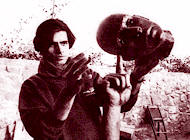
Sudarshan Shetty [India] 1993
“There's a kind of art that lives and
breathes in the gallery, on its own. But there is
also another form of art, which lives more in the
open and interacts more palpably with its audience.
I feel myself moving closer to the latter.” |
Sally Burton,
Visual Artist, New Zealand 2006-2007
"I have been inspired to use Sanskriti’s
collection of vessel forms as a narrative vehicle.
Acknowledging that clean packaged drinking water
has been a wonderful thing for this country, the
vast quantities of waste generated from plastic
bottles evokes nostalgia for the beauty of traditional
water vessels.
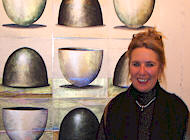
From a base of Tapa Cloth (traditional Pacific Island
material made from beaten paper mulberry bark) I
have collaged water bottle labels and overlayed
painted forms of Sanskriti’s collection of
water containers – Lots, Kalasha & Kumbha.
Working in modular units of nine, a simple bowl
form has also been used to explore gender issues.
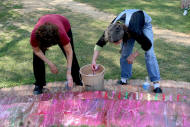
Light transparent bowl forms become the female principal
and reversed; dense and solid; the male principal
with reference to the Shiva Lingam. The many layers
of India’s immense history and diversity is
my third series, again over layed with simple bowl
forms. This universal shape has for me become a
symbol for humanity; open to ideas and offerings;
generous; and full of potential".
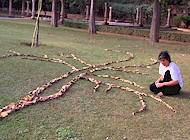
Vicky Shukuroglou, UNESCO Aschberg
Bursaries for Visual Arts, 2006-2007
"My residency at Sanskriti Kendra as a result
of a UNESCO Arts Bursary was extremely enriching
and informative for the development of my arts practice.
The interaction and exchange with fellow international
artists, local individuals and groups, was a valuable
experience.
A highlight of my residency was a series of arts
workshops I conducted a workshop with a group of
street children from the Salaam Baalak Shelter in
New Delhi. The primary aims of these workshops was
to introduce participants to alternative and imaginative
methods of visualising and creating, to give them
the opportunity to express their ideas and responses,
and to help them realise the potential of applying
creative thinking in everyday situations…..…...
There was a striking and rapid transition from their
restricted and timid expression at the start of
the workshop series, to a bold and free depiction
of their personal journeys. The workshops were supported
by Sanskriti and YouthReach, which offered a new
opportunity for the children to experience Sanskriti
and its museums.
Sanskriti’s support with transport for the
children and some materials was of significant assistance,
and the welcoming of thechildren to the grounds
was greatly appreciated".
Oscar Vargas de Calderon [Mexico]
UNESCO Visual Artist 1996-1997
"In the Kendra I share my time in working
and talking with the other artists in the residency,
with them I traveled within the country….As
a person the programme allowed me to know closer
another country and his people. As a painter it
was a good opportunity to work with the facilities
provided by the Kendra. And as an artist it was
an important step in my career , to realisation
my vocation and to enrich my experience.” |